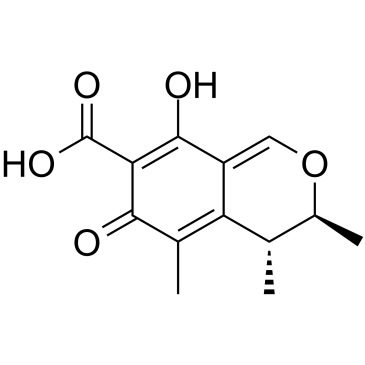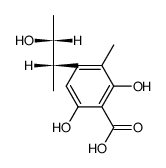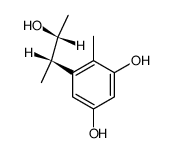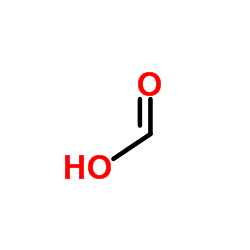518-75-2
| Name | (-)-citrinin |
|---|---|
| Synonyms |
(3R,4S)-8-Hydroxy-3,4,5-trimethyl-6-oxo-4,6-dihydro-3H-isochromene-7-carboxylic acid
4,6-dihydro-8-hydroxy-3,4,5-trimethyl-6-oxo-3H-isochromene-7-carboxylic acid Citriain Citrinin Cytrinine (3R,4S)-4,6-dihydro-8-hydroxy-3,4,5-trimethyl-6-oxo-3H-2-benzopyran-7-carboxylic acid citrinin,antimycin CIT (-)-Citrinin MFCD00006912 ,(3r-trans) EINECS 208-257-2 |
| Description | Citrinin is a mycotoxin which causes contamination in the food and is associated with different toxic effects. Citrinin is usually found together with another nephrotoxic mycotoxin, Ochratoxin A. Citrinin is also reported to possess a broad spectrum of bioactivities, including antibacterial, antifungal, and potential anticancer and neuro-protective effects in vitro[1][2]. |
|---|---|
| Related Catalog | |
| References |
| Density | 1.4±0.1 g/cm3 |
|---|---|
| Boiling Point | 409.8±45.0 °C at 760 mmHg |
| Melting Point | 175°C (dec.) |
| Molecular Formula | C13H14O5 |
| Molecular Weight | 250.247 |
| Flash Point | 156.6±22.2 °C |
| Exact Mass | 250.084122 |
| PSA | 83.83000 |
| LogP | 1.20 |
| Vapour Pressure | 0.0±2.2 mmHg at 25°C |
| Index of Refraction | 1.596 |
Synonym:None Section 2 - COMPOSITION, INFORMATION ON INGREDIENTS
Risk Phrases: 23/24/25 Section 3 - HAZARDS IDENTIFICATION EMERGENCY OVERVIEW
Toxic by inhalation, in contact with skin and if swallowed.Cancer suspect agent.The toxicological properties of this material have not been fully investigated. Potential Health Effects Eye: May cause eye irritation. Skin: May cause skin irritation. Harmful if absorbed through the skin. Ingestion: Harmful if swallowed. May cause irritation of the digestive tract. The toxicological properties of this substance have not been fully investigated. Inhalation: Harmful if inhaled. May cause respiratory tract irritation. The toxicological properties of this substance have not been fully investigated. Chronic: No information found. Section 4 - FIRST AID MEASURES Eyes: Flush eyes with plenty of water for at least 15 minutes, occasionally lifting the upper and lower eyelids. Get medical aid. Skin: Get medical aid. Flush skin with plenty of water for at least 15 minutes while removing contaminated clothing and shoes. Wash clothing before reuse. Ingestion: Never give anything by mouth to an unconscious person. Get medical aid. Do NOT induce vomiting. If conscious and alert, rinse mouth and drink 2-4 cupfuls of milk or water. Inhalation: Remove from exposure and move to fresh air immediately. If not breathing, give artificial respiration. If breathing is difficult, give oxygen. Get medical aid. Notes to Physician: Section 5 - FIRE FIGHTING MEASURES General Information: As in any fire, wear a self-contained breathing apparatus in pressure-demand, MSHA/NIOSH (approved or equivalent), and full protective gear. During a fire, irritating and highly toxic gases may be generated by thermal decomposition or combustion. Extinguishing Media: Use agent most appropriate to extinguish fire. Use water spray, dry chemical, carbon dioxide, or appropriate foam. Section 6 - ACCIDENTAL RELEASE MEASURES General Information: Use proper personal protective equipment as indicated in Section 8. Spills/Leaks: Clean up spills immediately, observing precautions in the Protective Equipment section. Sweep up or absorb material, then place into a suitable clean, dry, closed container for disposal. Provide ventilation. Section 7 - HANDLING and STORAGE Handling: Wash thoroughly after handling. Use with adequate ventilation. Avoid contact with eyes, skin, and clothing. Keep container tightly closed. Avoid ingestion and inhalation. Storage: Store in a tightly closed container. Store in a cool, dry, well-ventilated area away from incompatible substances. Hormones and antibiotics room. Section 8 - EXPOSURE CONTROLS, PERSONAL PROTECTION Engineering Controls: Facilities storing or utilizing this material should be equipped with an eyewash facility and a safety shower. Use adequate ventilation to keep airborne concentrations low. Exposure Limits CAS# 518-75-2: Personal Protective Equipment Eyes: Wear appropriate protective eyeglasses or chemical safety goggles as described by OSHA's eye and face protection regulations in 29 CFR 1910.133 or European Standard EN166. Skin: Wear appropriate protective gloves to prevent skin exposure. Clothing: Wear appropriate protective clothing to prevent skin exposure. Respirators: A respiratory protection program that meets OSHA's 29 CFR 1910.134 and ANSI Z88.2 requirements or European Standard EN 149 must be followed whenever workplace conditions warrant respirator use. Section 9 - PHYSICAL AND CHEMICAL PROPERTIES Physical State: Crystalline powder Color: yellow Odor: Not available. pH: Not available. Vapor Pressure: Not available. Viscosity: Not available. Boiling Point: Not available. Freezing/Melting Point: Not available. Autoignition Temperature: Not available. Flash Point: Not available. Explosion Limits, lower: Not available. Explosion Limits, upper: Not available. Decomposition Temperature: Solubility in water: Specific Gravity/Density: Molecular Formula: C13H14O5 Molecular Weight: 250.25 Section 10 - STABILITY AND REACTIVITY Chemical Stability: Stability unknown. Conditions to Avoid: Incompatible materials. Incompatibilities with Other Materials: Oxidizing agents. Hazardous Decomposition Products: Irritating and toxic fumes and gases. Hazardous Polymerization: Has not been reported Section 11 - TOXICOLOGICAL INFORMATION RTECS#: CAS# 518-75-2: DJ2275000 LD50/LC50: CAS# 518-75-2: Oral, mouse: LD50 = 105 mg/kg; Oral, rabbit: LD50 = 134 mg/kg. Carcinogenicity: Citrinin - Not listed by ACGIH, IARC, or NTP. Other: See actual entry in RTECS for complete information. Section 12 - ECOLOGICAL INFORMATION Other No information available. Section 13 - DISPOSAL CONSIDERATIONS Dispose of in a manner consistent with federal, state, and local regulations. Section 14 - TRANSPORT INFORMATION IATA Shipping Name: TOXIC SOLID, ORGANIC, N.O.S.* Hazard Class: 6.1 UN Number: 2811 Packing Group: II IMO Shipping Name: TOXIC SOLID, ORGANIC, N.O.S. Hazard Class: 6.1 UN Number: 2811 Packing Group: II RID/ADR Shipping Name: TOXIC SOLID, ORGANIC, N.O.S. Hazard Class: 6.1 UN Number: 2811 Packing group: II Section 15 - REGULATORY INFORMATION European/International Regulations European Labeling in Accordance with EC Directives Hazard Symbols: T Risk Phrases: R 23/24/25 Toxic by inhalation, in contact with skin and if swallowed. Safety Phrases: S 28A After contact with skin, wash immediately with plenty of water. S 36/37/39 Wear suitable protective clothing, gloves and eye/face protection. S 37 Wear suitable gloves. S 45 In case of accident or if you feel unwell, seek medical advice immediately (show the label where possible). WGK (Water Danger/Protection) CAS# 518-75-2: No information available. Canada None of the chemicals in this product are listed on the DSL/NDSL list. CAS# 518-75-2 is not listed on Canada's Ingredient Disclosure List. US FEDERAL TSCA CAS# 518-75-2 is not listed on the TSCA inventory. It is for research and development use only. SECTION 16 - ADDITIONAL INFORMATION N/A |
CHEMICAL IDENTIFICATION
HEALTH HAZARD DATAACUTE TOXICITY DATA
MUTATION DATA
|
| Symbol |


GHS02, GHS07 |
|---|---|
| Signal Word | Danger |
| Hazard Statements | H225-H302-H312-H319-H332 |
| Precautionary Statements | P210-P280-P305 + P351 + P338 |
| Personal Protective Equipment | Eyeshields;Faceshields;full-face particle respirator type N100 (US);Gloves;respirator cartridge type N100 (US);type P1 (EN143) respirator filter;type P3 (EN 143) respirator cartridges |
| Hazard Codes | T |
| Risk Phrases | 23/24/25-40-36/37/38 |
| Safety Phrases | S26-S36/37/39-S45 |
| RIDADR | UN 3462 6.1/PG 3 |
| WGK Germany | 3 |
| RTECS | DJ2275000 |
| Packaging Group | II |
| Hazard Class | 6.1(a) |
|
~% 
518-75-2 |
| Literature: Warren et al. Journal of the American Chemical Society, 1949 , vol. 71, p. 3422 Full Text View citing articles Show Details Schwenk; Schubert; Stahl Archives of Biochemistry, 1949 , vol. 20, p. 220,226 |
|
~% 
518-75-2 |
| Literature: Roedel, Thomas; Gerlach, Hans Liebigs Annalen, 1995 , # 5 p. 885 - 888 |

518-75-2 ~% 
518-75-2 |
| Literature: Johnson et al. Journal of the Chemical Society, 1950 , p. 2971,2973 |
|
~% 
518-75-2 |
| Literature: Asano et al. Yakugaku Zasshi, 1951 , vol. 71, p. 268,270 Chem.Abstr., 1952 , p. 485 |
|
~% 
518-75-2 |
| Literature: Cartwright; Robertson; Whalley Journal of the Chemical Society, 1949 , p. 1563,1566 |
|
~% 
518-75-2 |
| Literature: Wang; Ting Science Record (Peking), 1951 , vol. 4, p. 269,270 |
|
~% 
518-75-2 |
| Literature: Cartwright; Robertson; Whalley Journal of the Chemical Society, 1949 , p. 1563,1566 |






